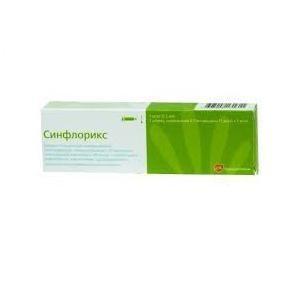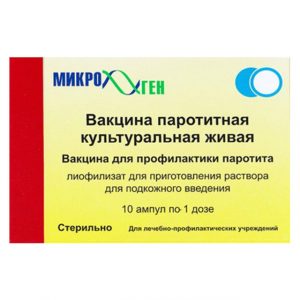Description
Release form
tablets
Packing
30 pcs.
Pharmacological action
An agent with antiproliferative, immunomodulating (immunosuppressive) and anti-inflammatory effects. The active metabolite of leflunomide A771726 inhibits the enzyme dehydroorotate dehydrogenase and has an antiproliferative effect. A771726 in vitro inhibits mitogen-induced proliferation and DNA synthesis of T-lymphocytes.
The therapeutic effects of leflunomide have been shown in several experimental models of autoimmune diseases, including rheumatoid arthritis.
Pharmacokinetics of
After oral administration, absorption is 82-95%. Eating does not affect the absorption of leflunomide.
Leflunomide is rapidly metabolized in the intestinal wall and liver to one major metabolite (A771726) and several minor metabolites, including 4-trifluoromethylalanine. Cmax of metabolite A771726 is determined within 1-24 hours after a single dose. In plasma, A771726 binds rapidly to albumin. The unbound fraction of A771726 is 0.62%.
The biotransformation of leflunomide in A771726 and the subsequent metabolism of A771726 itself are controlled by several enzymes and occur in microsomal and other cell fractions.
Traces of leflunomide are determined in plasma, urine and feces. Withdrawal A771726 is slow and is characterized by a clearance of 31 ml / h. T1 / 2 – about 2 weeks.
In patients on hemodialysis, excretion is faster and T1 / 2 decreases.
Indications
Basic treatment for rheumatoid arthritis in order to reduce the symptoms of the disease and delay the development of structural damage to the joints.
An active form of psoriatic arthritis.
Contraindications
Dysfunction of the liver, severe immunodeficiency states (including AIDS), severe disturbances in bone marrow hematopoiesis or anemia, leukopenia, thrombocytopenia as a result of other causes (except rheumatoid arthritis), severe infection, moderate or severe renal failure (due to little clinical experience), severe hypoproteinemia (including with nephrotic syndrome), pregnancy, lactation, child and adolescent age up to 18 years, hypersensitivity to leflunomide.
Use during pregnancy and lactation
Leflunomide may harm the fetus when taken by pregnant women. Leflunomide was teratogenic when administered orally to rats during organogenesis at a dose of 15 mg / kg (mainly anophthalmia or microphthalmia and internal hydrocephalus). The systemic exposure in rats at this dose was approximately 1/10 of the level of exposure based on AUC in humans. Under these conditions, leflunomide also caused a decrease in the body weight of females and an increase in embryo lethality and a decrease in the weight of the fetus of surviving newborns. In rabbits, oral administration of leflunomide at a dose of 10 mg / kg during organogenesis led to the formation of fused dysplastic sternum segments. The exposure level at this dose was almost equal to the maximum level of exposure based on AUC in humans. At a dose of 1 mg / kg, leflunomide did not show teratogenicity in rats and rabbits.
When exposed to female rats with leflunomide at a dose of 1.25 mg / kg, starting 14 days before crossing and ending lactation, a decrease in the survival of offspring by more than 90% is observed. The systemic exposure level at a dose of 1.25 mg / kg was about 1/100 of the human exposure level based on AUC.
Use in women of childbearing age. Adequate and strictly controlled studies to evaluate the effects of leflunomide in pregnant women have not been conducted. However, based on data from animal studies, leflunomide may increase the risk of fetal death when taken during pregnancy. Women of childbearing age should not begin treatment with leflunomide until pregnancy is excluded and (or) confirmation of the use of reliable contraception. Before starting treatment with leflunomide, patients should be fully consulted about the potential serious danger to the fetus.
Patients should be warned that for any delay in menstruation or other reason suggesting pregnancy, they should immediately notify the doctor to undergo a pregnancy test, and if the result is positive, the doctor and patient should discuss the risk for pregnancy. It is likely that a rapid decrease in the level of active metabolite in the blood when using the drug withdrawal technique, at the first delay of menstruation, can reduce the risk of using leflunomide for the fetus.
All women of childbearing age after discontinuation of leflunomide treatment are recommended to undergo the drug withdrawal procedure. Women undergoing treatment with leflunomide and wanting to become pregnant need to stop taking the drug and undergo a withdrawal procedure, including confirmation of a decrease in plasma M1 metabolite level lower than 0, 02 mg / l (0.02 μg / ml). It is believed based on animal studies that when the concentration of the active metabolite M1 in human plasma is lower than 0.02 mg / L (0.02 μg / ml), the risk is minimized.
FDA category of action on the fetus is X.
Breastfeeding. Leflunomide should not be used while breastfeeding. It is not known whether leflunomide is excreted in breast milk. Since many drugs penetrate the milk of lactating women, there is a likelihood of serious adverse reactions in children who are breast-feeding under the influence of leflunomide. However, the decision to start treatment with leflunomide or to continue breastfeeding should be made taking into account the importance of the drug to the mother.
Special instructions
Use is possible only after a thorough medical examination of the patient.
Before starting treatment, it should be borne in mind the possibility of increasing the number of side effects in patients who previously received other basic drugs for the treatment of rheumatoid arthritis, which have hepatotoxic and hematotoxic effects.
The active metabolite of leflunomide A771726 is characterized by a prolonged T1 / 2. Therefore, side effects can occur even after discontinuation of leflunomide treatment. In the event of similar cases of toxicity or when switching to taking another basic drug after treatment with leflunomide, a washing procedure should be carried out (after stopping treatment with leflunomide, colestyramine is prescribed at a dose of 8 g 3 times / day for 11 days or 50 g of powdered activated carbon, 4 times / day for 11 days).
It should be borne in mind that with the development of severe dermatological adverse reactions, severe infections, the administration of leflunomide should be discontinued and the washing procedure immediately started.
Patients with tuberculin reactivity should be monitored because of the risk of tuberculosis activation.
Given the prolonged T1 / 2 of leflunomide, vaccination with live vaccines is not recommended during treatment.
Composition
1 tab. contains leflunomide – 10 mg
Dosage and Administration
Initial dose – 100 mg daily for 3 days. Maintenance dose – 10-20 mg 1 time / day.
The therapeutic effect is manifested after 4-6 weeks from the start of administration and may increase within 4-6 months.
Side effects
From the cardiovascular system: often – increased blood pressure.
From the digestive system: often – diarrhea, nausea, vomiting, anorexia, lesions of the oral mucosa (aphthous stomatitis, ulceration of the lips), abdominal pain, increased levels of liver enzymes (especially ALT, less often – GGT, ALF, bilirubin) rarely – hepatitis, jaundice, cholestasis in some cases – liver failure, acute liver necrosis. On the part of the musculoskeletal system: often – tenosynovitis is possible – ligament rupture.
Dermatological reactions: often – hair loss, eczema, dry skin are possible – Stevens-Johnson syndrome, Lyell syndrome, erythema multiforme.
From the hematopoietic system: often – leukopenia (white blood cells more than 2000 / μl) are possible – anemia, thrombocytopenia (platelets less than 100,000 / μl) rarely – eosinophilia, leukopenia (white blood cells less than 2000 / μl), pancytopenia in some cases – agranulocytosis. The risk of developing hematological disorders increases with the recent, concomitant and subsequent use of myelotoxic drugs.
Allergic reactions: often – a rash (including maculopapular), atypical itching – urticaria in some cases – anaphylactic reactions.
On the part of metabolic processes: mild hyperlipidemia, hypophosphatemia, decreased uric acid levels. Laboratory data (not clinically confirmed) indicate a slight increase in LDH, CPK.
Other: in some cases – the development of severe infections and sepsis may develop rhinitis, bronchitis and pneumonia. When using immunosuppressive drugs, the risk of developing malignant and some lymphoproliferative processes increases. The possibility of a reversible decrease in sperm concentration, total sperm count and motility cannot be ruled out.
Drug Interactions
Increased adverse reactions may occur with recent or concomitant use of hepatotoxic or hematotoxic drugs or when these drugs are started after treatment with leflunomide without a washing procedure.
In vitro studies have shown that the metabolite of leflunomide A771726 inhibits the activity of the CYP2C9 isoenzyme. With simultaneous use with drugs metabolized by this enzyme system (phenytoin, warfarin, tolbutamide), the development of undesirable effects of drug interaction cannot be ruled out.
Storage Conditions
In a dry, dark place at a temperature not exceeding 25 ° C.
Term hodnosty
3 years
Terms of dispatch from
pharmacies Prescription
lekarstvennaja form
tablets




